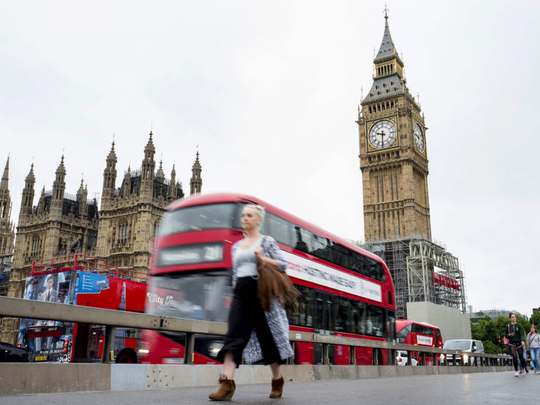
There may be few things quite so revealing about a country’s sense of itself as the icons it venerates. Americans have particular reason to contemplate this truism as the battle over statues of Confederate generals begins to look like an existential crisis for the United States President Donald Trump. But in a very minor key, Britain too is experiencing a skirmish over symbols of national identity. Edmund Beckett Denison is not a name that rings down the ages. No one learns about him at school.
British Prime Minister Theresa May probably wouldn’t recognise it, although she has climbed aboard the bandwagon, decrying the length of time it will take to restore his handiwork. But without this eccentric Victorian polymath, there would be no anguish at the silencing of Big Ben, no sense that somehow the beating heart of the United Kingdom is being stopped, in a nightmare metaphor for the state of the world. Denison was a lawyer, an amateur architect and a master of horology whose most public legacy is the British parliament’s clock.
It is the silencing of Big Ben, the hour bell that Denison designed to ring out across London, that has fired up talk of Hitler and health and safety (as in, Hitler couldn’t silence Big Ben, but health and safety can, in case you can’t see how the two go together). Denison designed the clock to meet the exacting criteria of the committee in charge of rebuilding the palace of Westminster after the fire of 1834. While the design of the building was a kind of architectural tribute to the idea of England as the pinnacle of democratic advance, decorated internally with tableaux of a nation’s inexorable progress through history, the clock and its bell had a different purpose: The clock’s mechanism was to be the most accurate ever built, a symbol of technological excellence and an advertisement of English expertise. It would stand at the heart of what would soon become an empire, its regularity and reliability a symbol of the orderly rule imposed under what later came to be called Pax Britannica.
Its bell, Big Ben, was the biggest ever cast, and it is said that when it was drawn from the docks through London to Westminster, it was to the cheers of a crowd eager to celebrate another example of English superiority. Unfortunately, the first version was found to be flawed and the great bell had to be recast before it could finally be installed at the top of St Stephen’s tower. On May 31, 1859, it rang out for the first time. The bell was so vast that it was considered prudent to bolt it in place rather than let it swing about. That meant that the hammer repeatedly struck it in the same place. Within six months, the bell was cracked and the hammer had to be replaced.
Yet, although the Observer published a dismissive report of “the disappointment, expense and failure” involved in the whole palace rebuilding project, the tower of St Stephen’s and its bell soon became as great an icon of world power as its designer hoped. (He was soon provoking a new storm of controversy by rebuilding St Alban’s cathedral at his own expense, and to his own taste). Meanwhile, as the new symbol of empire, Big Ben naturally became a target for radicals. By the early 1890s, it was meeting a variety of devastating fictional ends.
In the denouement of E. Douglas Fawcett’s early sci-fi novel, Hartmann the Anarchist, it was blown up in an aerial bombardment. While there are reasons for being sceptical of some of the claims of Victorian progress, it is hard not to admire the era’s appetite for science, technology and innovation. But last week’s furious reaction to the news that Big Ben is to be silenced for four years while it is overhauled and the fabric of the tower restored owes less to a lingering admiration of Victorian enterprise and much more to its role in the Second World War as the unbowed symbol of British resistance, an icon of the nation’s foundation myth. Big Ben is not the only icon of British national identity that is challenged by the passage of time.
Recently BT announced that 20,000 phone boxes are to be scrapped. Usage has plummeted by 90 per cent over the past 10 years, and keeping them all in working order costs £6 million (Dh28.34 million) a year. Astonishingly, 33,000 calls a day are still made. The news of the beginning of the end of a symbol of a 20th century commitment to collective provision has been greeted in silence. Yet, phone boxes were once a recognised part of Britain’s national identity, almost as powerful as Big Ben, but more demotic. From their introduction in the early 1920s, installed by the post office and indirectly paid for by the taxpayer, they made an indispensable communications technology universally accessible at a minimal cost as long as you had the right change. They are, obviously, more or less redundant. But then no one needs Big Ben to tell the time either. It depends what you value.
On the other hand, when Article 50 was triggered, the Brexit pledge was scheduled for the moment when Big Ben bongs midnight on March 30, 2019. Maybe that explains why so much heat has been generated in the Brexit-backing media about its silence. No bongs mean no Brexit.
— Guardian News & Media Ltd
Anne Perkins has been a leader writer, lobby correspondent and feature writer for the Guardian since 1997.










